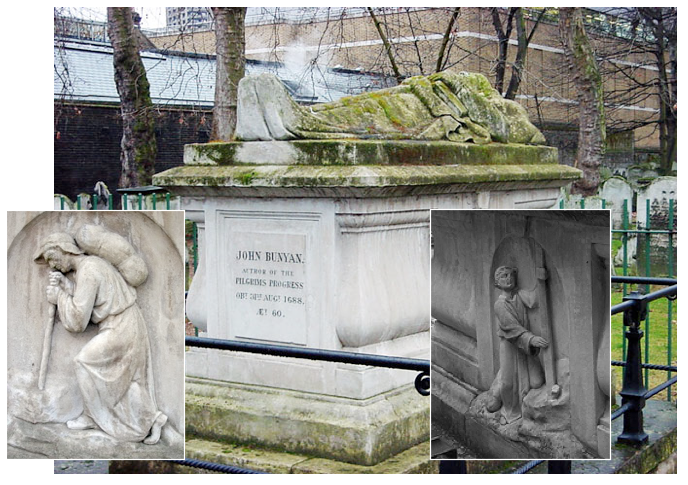On one side of John Bunyan’s tomb in London, there is a portrayal of the pilgrim Christian, struggling with his burden. The other side of the tomb shows Christian kneeling at the cross, with the burden rolled away.
That scene captures (for me) the most memorable part of Pilgrim’s Progress, where Christian finds salvation from his sins at the cross.
“He ran thus till he came at a place somewhat ascending; and upon that place stood a cross, and a little below, in the bottom, a sepulchre. So I saw in my dream, that just as Christian came up with the cross, his burden loosed from off his shoulders, and fell from off his back, and began to tumble, and so continued to do till it came to the mouth of the sepulchre, where it fell in, and I saw it no more.”
Have you ever read Pilgrim’s Progress? Charles Spurgeon remarked, “Next to the Bible, the book that I value most is John Bunyan’s Pilgrim’s Progress. I believe I have read it through at least a hundred times.” I’ve never read any book a hundred times. But in the handful of times I have read this book, I at least glimpse the value that Spurgeon understood.

All of these elements serve to teach the Bible to our minds and to stir our emotions to treasure our lives in Christ all the more.
As a boy, I recall reading with fascination as Christian battled Apollyon. I chuckled at some of his companions’ bumbling along the way. I’ve pondered the insights from his conversations. Perhaps you can remember similar experiences.
This story is accessible to all kinds of Christians, of all ages. You can read it in the classic version, or a modern-language version, and in pictures. (I’m currently looking for a good children’s edition. Recommendations, anyone?)
I wince a little when Christians excitedly describe the Twilight books or latest movie or TV show, while being ignorant of a genuinely helpful classic like Pilgrim’s Progress. If you haven’t read it yet, you should. This is a book for your enjoyment and faith.
About Ben Kwok


Ben,
great post. I suggest that Twilight is just tabloid light for teens.
Helen Taylor wrote a children’s version many years ago that has stood the test of time. I read it and re-read it when I was a kid and now my kids are reading it too. The cover is coming off it.
https://www.booksofthebible.com/p1037.html
Yep, classic work, not only of Christian writing but of English literature. It has had a profound influence on many writers and people over the 350 years it has been in publication.
For those interested, C.S Lewis wrote an excellent book about his own conversion called “The Pilgrim’s Regress.” Also, Nathaniel Hawthorne’s “The Celestial Railroad”, also inspired by Bunyan’s classic, gives a slightly more modern version but still hits hard, especially at modern Christianity.
Looking forward to introducing my kids to these and other great books.
Thanks Mark! I will pick that one up.
Steve, I think Hawthorne is great at depicting the sin nature and the failure of moralism, i.e. Scarlet Letter. Both his work and Lewis’ Pilgrim’s Regress seem a little on the darker side in that they focus on humanity’s failure apart from God. What do you think?
I’m pretty sure Pilgrim’s Progress has more copies in print than any other English book in history besides the Scriptures.
I’m almost embarrassed to admit I haven’t finished reading this book! I have to go through it again sometime. I remember a film that was a modern rendition of the book that I watched; it was quite nice. It’s easy to find yourself next to Christian as he goes through these various parts of the story.
Ben, I think all of Nathaniel Hawthorne’s short stories are a little on the darker side. I love them. Regarding his Celestial Railroad, it is a critique on the state Christianity had fallen to from the Puritan days, hence the Bunyan style allegory, and many references to Pilgrim’s Progress. I think his stories are dark because he was a melancholic kind of person.
Lewis, on the other hand, was commenting on the various philosophies of his day (and ours), systematically stripping down the facade of logic and reason that made them attractive to him, and exposing their weakness. In that sense, yes, he focused on humanity’s failure apart from God, the failure of human reasoning detached from the Scriptures.